
5 July 2013
Fake Trotskyists Can’t Tell the Difference Between a Workers Union and a Death Squad
SL on
Corporatism in Mexico:
Games Centrists Play
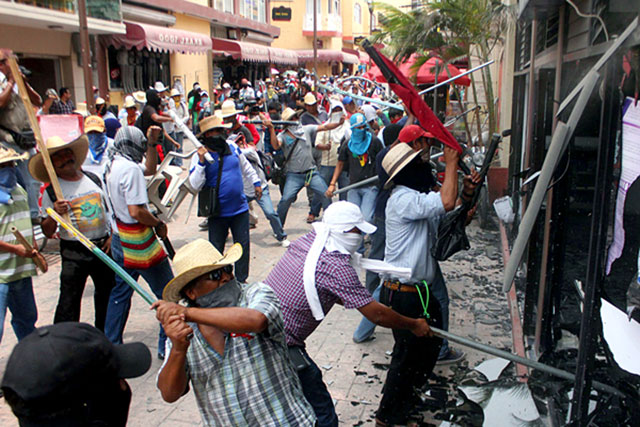
Insurgent teachers in Chilpancingo, capital of the state of Guerrero, taking care of business at office of National Action Party (PAN) and other ruling parties and government agencies responsible for the capitalist counter-reform of education, April 25. (Photo: European Pressphoto Agency)
In the article “Mexico: For a National Education Strike” (The Internationalist No. 34, March-April 2013, translated from Revolución Permanente No. 2, May 2013, the newspaper of the Grupo Internacionalista, Mexican section of the League for the Fourth International), we reported on the militant month-long walkout by teachers in the state of Guerrero against the education “counter-reform” being pushed through by Mexico’s three main capitalist parties, the PRI (Institutional Revolutionary Party), PAN (National Action Party) and PRD (Party of the Democratic Revolution).
In an accompanying box, “Defend the Independent Teachers of Guerrero!” we reported how angry strikers of the local affiliate of the National Coordinating Committee of Education Workers (CNTE) stormed the offices of the PRI, PAN, PRD and a minor bourgeois party in the state capital the day after these parties voted to implement the anti-teacher “reform” at a secret meeting of the state legislature hiding out in Acapulco. We noted as well that the strikers and teachers college students torched the offices of the CTM (Confederation of Mexican Workers) and stoned the headquarters of the SNTE (National Union of Education Workers), both of which are not workers unions but corporatist agencies of the capitalist state whose function is to quell labor unrest.
The fury of the teachers against the state-controlled entities is the result of decades of brutal repression of the teachers by these labor cops of the bourgeoisie. The SNTE has long maintained squads of gunmen who from 1989 to 2006 killed more than 150 dissident teachers, and particularly in the state of Oaxaca have murdered more than two dozen since then.1 We remarked that, “It would be interesting to know from the fake Trotskyist Grupo Espartaquista de México [GEM], which insists that the CTM and SNTE are workers unions, if it today defends the battle-hardened Guerrero teachers against capitalist repression, or if as the CTM ‘socialists’ they are they defend the hated SNTE against the fully justified rage of the Guerrero teachers.”
In response, Workers Vanguard (No. 1025, 31 May), the newspaper of the Spartacist League/U.S., published a lengthy screed titled “IG Chokes on Defense of Mexican Teachers Union” intended to throw sand in the eyes of its readers with a litany of lies and distortions. The core of the SL’s dishonest attack is to accuse the Internationalist Group (it never mentions the Mexican Grupo Internacionalista) of having a “union-busting line” on the SNTE and “add[ing] grist to the union-busters’ mill.” Our one-sentence response is that the latter-day SL and WV can’t tell the difference between a workers union and a death squad, and are in fact alibiing the main union-busting agency of the capitalist state in Mexico.
This is not a minor difference, especially for revolutionaries active in workers struggles in Mexico, as GI supporters are, both in independent unions and in the state-controlled labor agencies. But for the SL, its International Communist League and its Mexican affiliate, the GEM, it’s all a game. The consequences of an incorrect line don’t bother them in the least: it’s just one more polemical stick to use against the LFI. Thus implicitly responding to our challenge, the Workers Vanguard article calls to “Drop all charges against the Guerrero protesters,” but in two tabloid newspaper pages WV never mentions that the arrested union leaders were charged with instigating the striking teachers, who attacked the offices of the very corporatist outfits the SL pretends are unions!
That corporatist state control of labor continues to be a burning issue in Mexico today was underscored at the end of June when the national SNTE leadership had state police in Chiapas attack and shut down the congress of its state affiliate (Section 7), arresting 29 union leaders and bloodily beating 200, because the dissident teachers of the CNTE had a clear majority of the delegates (see box). And the SL claims the SNTE is a legitimate union! Try telling that to teachers in Chiapas with blood streaming down their faces, to the Guerrero teachers jailed for attacking the SNTE, or to Oaxaca teachers facing SNTE pistoleros and death squads.
Corporatism and Popular Frontism
In order to enlighten readers rather than deliberately obfuscating, as the SL/WV does, a brief description of labor corporatism in Mexico is in order, since most readers in the U.S. and internationally may be unfamiliar with this. Mexico’s labor law was explicitly modeled on that of Mussolini’s corporatist fascist regime in Italy during the 1930s. Like a number of semi-colonial countries, Mexico was ruled at that time and up until 2000 by a regime that for decades sought to incorporate all sectors of society within the single state party. Unions, peasant confederations, doctors associations, musicians organizations, women’s groups, student leagues, a military sector later folded into a “popular sector” along with small business syndicates, the teachers union, etc., were all officially part of the PRI.
This system took form in the 1930s, was solidified in the 1940s, was repeatedly challenged by worker, student and peasant unrest in the 1950s, ’60s and ’70s and then began to unravel in the 1980s. Because control of Mexico’s powerful working class was key to the regime’s survival, the PRI-government completely took over the unions in the late 1940s in a series of charrazos, imposing state-appointed leaders (charros, or cowboys) by attacking union meetings with thousands of troops and police and arresting hundreds of union leaders, some of whom were kept in jail for decades.
Even before then, Trotsky described Mexican unions in 1940 as “semi-state institutions,” but with the 1948-49 charrazos quantity turned into quality and these bodies ceased to be workers unions at all, turning into, and acting as, labor police. From that point onward, just about every significant labor struggle in Mexico (such as the 1958-59 railroad workers strike and the 1970s insurgency of electrical workers) was directed against these labor cops as workers desperately sought to break out of the straitjacket of state control. Meanwhile, the corporatist bureaucrats would move seamlessly from “union” leader to manager in the state-owned companies that controlled Mexico’s economy to PRI legislative posts. It was all one state-party apparatus.
This is quite different from labor unions in the U.S. and other imperialist countries. On the other hand, it is similar to the situation in other semi-colonial countries with one-party regimes, such as Brazil under Getúlio Vargas’ corporatist Estado Novo, Algeria after the FLN took power in the 1960s, or Egypt up until the overthrow of the Mubarak dictatorship in 2011. In Egypt today, as in Mexico, there is a class difference between the official state labor bodies and the new “independent” unions: even though the leaders of the latter are still politically tied to the bourgeoisie, they are not state or ruling-party functionaries or leaders answerable to the government, not the union ranks.
As the PRI regime began coming apart in the 1980s, in good part because the “free market” economic policies dictated by Washington made Mexico’s state companies an anomaly, some local and state affiliates of the government-controlled “unions” managed to gain autonomy and began acting independently. The CNTE, beginning in Oaxaca, gained control of several state sections of the SNTE. In other cases, national unions such as the telephone workers broke away from the CTM and other corporatist federations, and new independent unions arose as well.
Along with this evolution, in order to keep political control of the unions that had slipped the government’s leash, the Mexican bourgeoisie came up with a new political configuration. Instead of a single all-encompassing state party, an opposition popular front was formed around the figure of former PRI leader Cuauhtémoc Cárdenas (and his successor Andrés Manuel López Obrador, or AMLO) and around the PRD, a new nationalist-populist bourgeois party led by former PRI politicians and staffed by ex-leftists. The popular front was the organizational vehicle to keep the new “independent” unions politically in line.
When the PRI lost the Mexican presidency in the 2000 elections, after running the country for an unbroken stretch of 70 years, it was widely expected that the corporatist “unions” would collapse or break away as the new right-wing free-market clericalist National Action Party (PAN) took over. However, by and large that did not happen. Partly this was because the PRI continued to control a number of state governments, but more fundamentally, the PAN under presidents Vicente Fox and Felipe Calderón discovered that it needed the corporatist labor agencies to keep worker unrest from exploding.
A proof that these are not just PRI-led unions as opposed to PRD-led unions, as the SL/ICL and GEM claim, is that under 12 years of PAN governments, the CTM, SNTE, CROM, CROC, STPRM (oil workers), SUTERM (electrical workers, opposed to the independent SME electrical workers union) and other corporatist labor outfits continued to act as state agencies just as they had earlier under the PRI. The SNTE under Elba Esther Gordillo helped line up PRI governors to support PAN candidate Calderón in the aftermath of the rigged 2006 election and even set up its own party, PANAL, to ally with the ruling PAN. At the same time, the SNTE was at the forefront of designing and, as top government education officials, enforcing anti-teacher education “reforms” and shoving them down the throats of its members.
Meanwhile, the popular front did its job of defusing labor militancy among the independent unions. Thus when in October 2009 PAN president Calderón suddenly fired all 44,000 electrical workers of the SME and dissolved the government-owned company they worked for, the SME leadership in alliance with the popular front around AMLO and the PRD managed to divert the ranks’ anger and the solidarity marches of several hundred thousand workers into pressuring Congress and the Supreme Court, eventually running the struggle into the ground. The Grupo Internacionalista actively participated in the defense of the SME while criticizing the policies of the leadership and insisting on the need to break with the popular front (see “Mexico Electoral Farce 2012: Militarization and Anti-Worker Attacks,” The Internationalist, May 2012).
The Grupo Internacionalista has fought to break the corporatist stranglehold on the Mexican proletariat at the same time as we call on workers to break politically from the bourgeois popular front. The SL/ICL, on the other hand, denies that there is a qualitative difference between the corporatist “unions” directly controlled by the state and the independent unions whose leaders politically support the bourgeoisie. At the same time they deny that there is, or even could be, a popular front in Mexico, view they came up with in 1997 just as the popular front was poised to take government office for the first time in the federal district (Mexico City).
In both cases, on corporatism and the popular front, they were abandoning what had been the characteristic positions of the Spartacist tendency in Mexico up until the ICL expelled long-time leading cadres in the U.S. and the leadership of its Mexican section in 1996. And in both cases, the SL/ICL’s revisions served to justify abandoning struggle within the working class against the mechanisms of organizational and political control by the bourgeoisie (see “Mexico: To Fight the Popular Front You Have to Recognize That It Exists,” reprinted in The Internationalist No. 3, September-October 1997).
SNTE Serves as Instrument of Bourgeois Attack on Mexican Teachers
As in the United States, teachers in Mexico have been a prime target of the capitalist offensive against working people. Unlike in the U.S., Mexican teachers have fought back with militant struggles. In the U.S., even though the leadership of the teachers unions (AFT, NEA) have sought to collaborate with the corporate education “reformers,” the latter have directed their fire against the unions which they seek to destroy. In Mexico, the ruling-class offensive is directed against the combative state teachers unions led by the dissident CNTE while the government continues to use the SNTE as a battering ram against independent teacher unionism.
This situation came to a head at the end of February the PRI president Peña Nieto ordered the arrest of SNTE president-for-life Elba Esther Gordillo. As we explained in our article (“Mexico: Labor Cop Gordillo Busted to Crush Teachers’ Resistance,” The Internationalist No. 35, March-April 2013), the SNTE boss was “the perfect target in order to promote Peña Nieto’s privatization agenda,” not because she opposed it (in fact she emphatically supported the anti-teacher “reform”) but because her obscene corruption made her an ideal scapegoat in order to go after the CNTE which was actually leading the resistance.
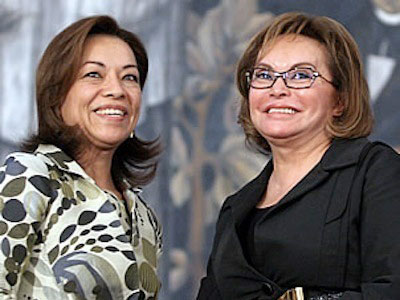 Elba
Esther Gordillo (right) with then-Secretary of Education
Josefina Vázquez Mota of the PAN, back when the SNTE
president-for-life had the federal Education Secretariat under
her control.
Elba
Esther Gordillo (right) with then-Secretary of Education
Josefina Vázquez Mota of the PAN, back when the SNTE
president-for-life had the federal Education Secretariat under
her control.The Workers Vanguard article says “Gordillo’s arrest is a direct attack on the teachers union and the entire Mexican labor movement,” part of a bourgeois drive to “dismantle the unions.” Yet Peña Nieto went out of his way to insist he was not attacking the SNTE, that he would maintain “a respectful and constant dialogue with the SNTE” (La Jornada, 28 February). For his part, the new head of the SNTE, Juan Díaz de la Torre, announced upon taking office that he “supports” the education reform and would “calm down” any protests (La Jornada, 3 March). He has since repeatedly “reaffirmed” and “ratified” his support to Peña Nieto and his “commitment … to concretizing educational reform” (speech on the Day of the Teacher, May 15).
This love fest is not surprising considering that the new SNTE president was handpicked by the Mexican president. The very process by which Díaz de la Torre was selected shows the corporatist, state-controlled character of the SNTE. Hours after Gordillo was arrested, the union convention meeting in Guadalajara hastily rewrote the statutes to allow Díaz, her top aide, to succeed her. But the next morning, he got a call from Government Secretary Osorio Chong summoning him to Mexico City. Díaz hops on a plane, goes to meet the secretary, is handed a message from the president instructing him to “not get involved in the Elba case and to arrive at solutions … on educational reform.” The new SNTE president signs and delivers and heads back to Guadalajara where the “union” congress ratifies Peña Nieto’s man, 268 votes to 0.
None of this, of course, is in the Workers Vanguard account which pretends that Gordillo’s arrest was an attempt to “dismantle the unions.” What’s striking is that it is a replay of how Gordillo herself was summoned to the Government Secretariat in 1989 to be installed as SNTE president after her predecessor, Carlos Jonguitud, was called to the presidential residence of Los Pinos to be informed of his “resignation.” In both cases, the ousted leaders were long-time obedient, corrupt and murderous agents of the regime who had outlived their usefulness and were dumped. But the “union” went on functioning as a state agency without a hitch. Díaz de la Torre naturally denounced the militant Guerrero teachers’ actions as serving “outside interests.”
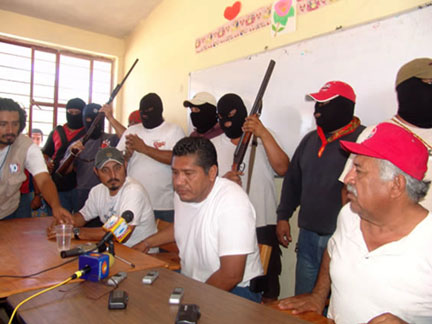 The paramilitary group led
by Humberto Alcalá Betanzos (center), the founder of Section
59 of the SNTE and PRI politician in Lalloaga, Oaxaca (2009).
The paramilitary group led
by Humberto Alcalá Betanzos (center), the founder of Section
59 of the SNTE and PRI politician in Lalloaga, Oaxaca (2009).The SNTE not only backs the government against the militant teachers, it actually spearheads the attacks on teachers’ rights. The SNTE helped design the ENLACE student exam whose scores will be used to evaluate teachers’ “value added,” and under Calderón, Gordillo had her son-in-law named assistant secretary of education of the federal government. We have reported how CNTE teachers in Oaxaca, Michoacán and Guerrero boycotted the ENLACE exams and teacher evaluations (see The Internationalist, Summer 2012). But in Oaxaca, where at the height of the 2006 uprising the SNTE set up a Section 59 to fight the CNTE-affiliated Section 22, guns in hand, the SNTE loyalists have demanded (unsuccessfully) that the exam be administered in the state (“In Oaxaca, SNTE Asks to Apply ENLACE,” El Economista, 5 June).
So there is an offensive against militant teacher unionism in Mexico and it is led by the corporatist, state-controlled SNTE. SNTE flunkies in Oaxaca regularly scab on teacher strikes of tens of thousands called by the CNTE-affiliated Section 22. And the murders of teachers by assassins contracted by or on the payroll of this pseudo-union continue. At least 33 teachers in Oaxaca have been shot down or otherwise killed in the struggle from 2006 on, half a dozen of them by gunmen of the SNTE’s Section 59. Thus in alibiing the SNTE as a supposed workers union, the SL and the GEM are acting as apologists for scabs and union-busting labor cops who employ death squads.
Who Supported Mexican Miners’ Strikes
The WV article then tries to generalize its accusation against us as aiding and abetting union-busting by admitting that, yes, corporatism did exist in Mexico once upon a time in the distant past, “But corporatism has been in agony for some time,” it claims, despite the evidence that corporatist “unions” still manage to suppress worker unrest. And not only with the teachers: in 2009-12 the corporatist SUTERM supplied scabs to help destroy the independent SME electrical workers union. “PRI-affiliated unions often engage in economic strikes,” says WV. Instead of “often,” try “seldom” or “almost never.” In fact, the corporatist CTM, CROC and CROM labor federations are notorious for signing “protection contracts” with companies in order to keep real unions out and prevent economic strikes.
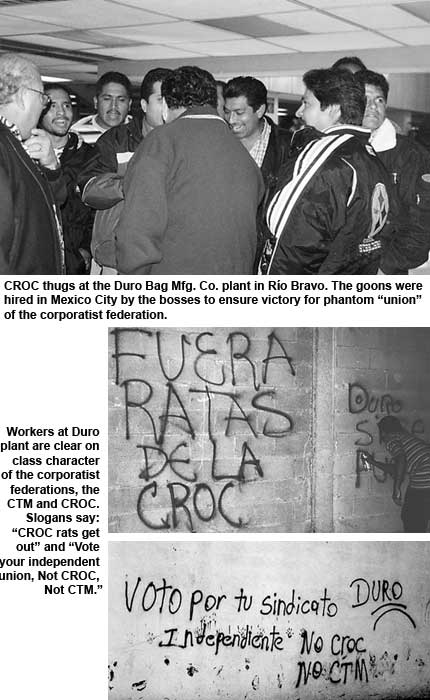 Often workers in plants
supposedly organized by these corporatist labor cops don’t
even know there is purportedly a union there until they try to
organize one. When women workers in the maquiladora factories in
free trade zones along Mexico’s northern border tried to
register a union in 2001, they discovered phantom CTM and CROC
(Revolutionary Confederation of Workers and Peasants) “unions”
located in the company labor relations office. The women
expressively wrote “CROC rats out!” on the walls (see “Mexico:
Women Workers Battle Gun Thugs,” The
Internationalist No. 10, June 2001, and “Mexican
Maquiladora Workers Fight for Their Rights,” The
Internationalist No. 1, January-February 1997).
Often workers in plants
supposedly organized by these corporatist labor cops don’t
even know there is purportedly a union there until they try to
organize one. When women workers in the maquiladora factories in
free trade zones along Mexico’s northern border tried to
register a union in 2001, they discovered phantom CTM and CROC
(Revolutionary Confederation of Workers and Peasants) “unions”
located in the company labor relations office. The women
expressively wrote “CROC rats out!” on the walls (see “Mexico:
Women Workers Battle Gun Thugs,” The
Internationalist No. 10, June 2001, and “Mexican
Maquiladora Workers Fight for Their Rights,” The
Internationalist No. 1, January-February 1997).
That’s who the SL and GEM are apologizing for: company “unions” employing gun thugs that the workers call “rats.” But what do these cynical centrists care? Their only interest in the whole question is in order to “get” the IG and GI by pretending that any outfit that calls itself a union is one. With supreme imperialist arrogance (and ignorance) they claim that Mexico is no different than the U.S., that “unions” with death squads killing scores of their members (over 100 teachers in Oaxaca alone) are the same as the Teamsters under Jimmy Hoffa. We wonder how many of them have ever been near a maquiladora, whereas comrades of the IG and GI have been to free-trade zone industrial parks and met with maquiladora workers trying to organize genuine worker unions in Río Bravo, Reynosa, Nuevo Laredo, Tijuana, Guadalajara and elsewhere.
In expanding its smears, Workers Vanguard claims that “the IG refused to defend the SNTMMSRM [mine and metal workers] leadership or the union itself against the state” when in 2006 its leader, Napoleon Gómez Urrutia was accused of money laundering by the PAN government, and that we “omitted any call for victory to the strikes or for dropping the charges” against him. For starters, the nationwide strike called by the SNTMMSRM in February 2006 lasted all of 72 hours, and was called off as soon as the government labor arbitrators ruled it “non-existent,” as Gómez Urrutia dutifully followed the corporatist labor laws. We supported that brief strike and opposed the government’s attempt to oust the SNTMMSRM leadership:
“Although it is a settling accounts within the regime it affects the workers, and therefore it is necessary to reject this frontal assault by the government.
“When the bosses government replaces its labor representatives, it does so in order to intensify repression and implement more ‘labor restructuring’ measures. … [Miners and metal workers] should resist all attempts by the government to impose or maintain its control over the workers. It is the workers themselves who should get rid of Gómez Urrutia’s corrupt and venal charro apparatus, not the bosses’ government that he has served historically.”
– El Internacionalista special supplement, May 2006
We also detailed the history of SNTMMSRM integration in the capitalist state, Gómez Urrutia’s role as a top labor lieutenant of the PAN government and his complicity with the “industrial murder” at the Pasta de Conchos mine that sparked the whole confrontation. The GEM made no mention of any of this, no call for union independence from the capitalist state, not a word of criticism of Gómez Urrutia. Also in our supplement, responding to a murderous attack on workers at the Sicartsa steel mill in Michoacán, we called for a national strike against repression. The GEM mocked our call, leaving Sicartsa workers to strike alone without any support from the SNTMMSRM, ever obedient to Mexico’s corporatist labor laws.
We intensified our call for national strike action as the government attacked peasants in Atenco in May 2006 and Oaxaca teachers in June. The Internationalist Group in the U.S. initiated several protests in New York against repression in Oaxaca. In Mexico, over the next five months of intense struggle that drove the police and the government from the state capital, the Grupo Internacionalista sent virtually our entire membership to Oaxaca, some for extended periods. We intervened at forums there warning against popular-front sellout of the struggle and calling for no support to the bourgeois PRD (see The Internationalist No. 24, Summer 2006, and No. 25, January-February 2007). In an expression of political bankruptcy, the GEM sat it out.
But the story doesn’t end there. When the Workers Vanguard article mentions “a series of powerful strikes” in the mining sector it is referring above all to the lengthy strike at the Cananea mine in northern Mexico. Here we confront a contradictory situation as labor corporatism in Mexico partially unravels. The SNTMMSRM, like the SNTE, has not broken with state control of labor, and Gómez Urrutia has been careful to play by the rules. Yet some locals, notably Section 65 in Cananea, have struck independently of (and been stabbed in the back by) the national “union.” How then do revolutionaries intervene?
Far from “writing off” the Cananea local, we came to its aid. Supporters of the Grupo Internacionalista in the Comité de Lucha Proletaria (Proletarian Struggle Committee) who were active in the SITUAM university workers union put forward a motion to send a caravan to support the embattled miners. Our comrades organized and led the delegation that traveled to the struck mine in northern Mexico. We published a special supplement with articles supporting their strike, detailing dangerous conditions at the mine and recounting the history of joint struggle by Mexican and U.S. workers in Cananea going back a century (see “Cananea Must Not Stand Alone! For a Nationwide Miners Strike!” The Internationalist No. 29, Summer 2009, translated from El Internacionalista supplement, February 2008).
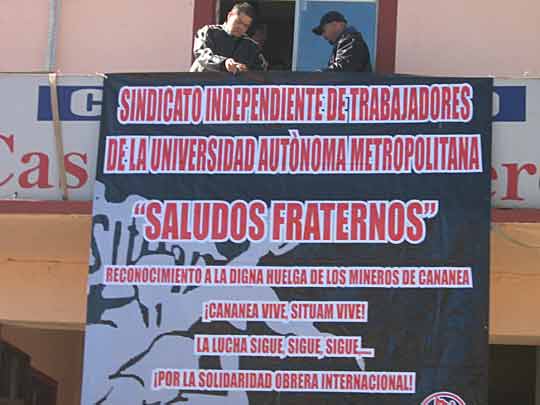 Workers hang banner of
solidarity greetings from Union of Workers of the Metropolitan
Autonomous University (SITUAM) to striking Cananea miners,
December 2007. Banner says “For International Workers
Solidarity!” (Photo: El
Internacionalista)
Workers hang banner of
solidarity greetings from Union of Workers of the Metropolitan
Autonomous University (SITUAM) to striking Cananea miners,
December 2007. Banner says “For International Workers
Solidarity!” (Photo: El
Internacionalista)In those articles, distributed in Cananea, we also spelled out the history of the corporatist SNTMMSRM’s betrayal of the combative Local 65, at the same time as we called to “demand that all the charges against leaders of ostensible labor organizations be dropped, since they serve as an attack by the capitalist state against the mine workers.” So the situation is contradictory when you have militant locals that have partially broken from corporatist national “unions.” And both in the case of the teachers (CNTE) and the miners (Section 65), the Grupo Internacionalista has supported their struggles while fighting for full independence from the capitalist state. The SL, incapable of handling contradictions, resolves them by smearing the IG, and doing nothing.
From Mexico to Brazil: SL Sophistry and Litany of Lies
Similarly over the conflicts between the dissident CNTE and the corporatist SNTE, Workers Vanguard asks, thinking it has somehow nailed us, how can the CNTE lead current protests against the education reform “as a component of what the IG dismisses as a ‘labor police agency’.” Answer: the CNTE-led state unions are not controlled by, act independently of, oppose and are opposed by the corporatist SNTE. Next WV asks: “So why would the government weaken” the SNTE by prosecuting Gordillo, if, as we say, it is a “labor police force that blocks the mobilization of the teachers.” Answer: the government didn’t weaken the SNTE, it dumped its agent who had become a liability and replaced her by another flunkey.
The SL’s inability to grasp contradiction reflects a broader loss of capacity of dialectical thought, which has reflected itself in its endless gyrations over whether the Stalinist bureaucracy “led the counterrevolution” in East Germany and the Soviet Union. As this once-revolutionary organization slides deeper and deeper into centrism, discarding one Trotskyist principled position after another – abandoning the call to defeat U.S. imperialism in Afghanistan in 2001 (while vilely smearing the IG as purveyors of “anti-Americanism” for upholding that call), then shamefully supporting “its own” imperialism over the U.S.’ invasion of Haiti in 2010 – you can see the Marxist IQ points slipping away. Opportunism blinds people and makes them stupid.
So next up in Workers Vanguard’s laundry list are its habitual lies about Brazil, that while calling for “total political independence from the bourgeois state,” our comrades in the Liga Quarta-Internacionalista do Brasil (which the article also never mentions, just like it pretends the Grupo Internacionalista doesn’t exist) supposedly “in the city of Volta Redonda dragged the municipal workers union through the bourgeois courts in 1996-97.” This is a monstrous fabrication. The LQB and its members never took the union to court, and in fact they were the leadership of the union and they were sued in the bourgeois courts by pro-police elements whose lies the SL/ICL repeats in its factional zeal against the Brazilian comrades it deserted.
We have amply documented the persecution of our comrades and the despicable role played by the SL/ICL in two dossiers, Class Struggle and Repression in Volta Redonda, Brazil (February 1997) and Responses to ICL Smear Campaign Against Brazilian Trotskyists (May 2010). The latter has a dozen articles responding to and exposing the SL’s slanders. Both bulletins are packed with illustrations of the nine different court suits against the Trotskyist union militants, and show that after the courts removed them from their elected positions on bogus charges, when judges finally found in their favor our comrades refused the offer of the court to reinstate them, because we oppose any intervention in union affairs by the bourgeois state.
What this was all about is that the Brazilian comrades, encouraged by the ICL, had acted to remove municipal police from the municipal workers union which they had won the leadership of (on a program saying that no cooperation with the police was possible since all police are the armed fist of the bourgeoisie). When supporters of the police pushed back, the ICL jumped ship, breaking fraternal relations with the LQB the day before police shut down the union assembly that was to vote to remove the cops. WV says this was a “cop-infested union,” but no more so than unions the SL has had supporters in. Yet while the SL has long purported to be for “cops out of the unions,” it has never waged a campaign in the unions to kick the police out, while the Brazilian comrades did. And for that they were persecuted, as the ICL sought to sabotage their defense.
The SL/ICL on Corporatism When It was Trotskyist
Then we come to a section titled “Norden in His Labyrinth,” which purports to show that when Jan Norden, now editor of The Internationalist, was for 23 years editor of Workers Vanguard, WV supposedly didn’t hold that the corporatist labor bodies were institutions of the capitalist state. Wrong again. Their supposed proof is that in 1989 when Joaquín Hernández Galicia (known as La Quina), president of the STPRM oil workers, was arrested by PRI president Salinas de Gortari, WV published an article that, while correctly defending La Quina, wrongly equated the STPRM with U.S.-style unions. “The IG is left to explain what has changed since then.”
The fact is that prior to the expulsion of the Spartacist cadres in the U.S. and Mexico in 1996, publications of the SL, GEM and ICL all repeatedly explained – in at least a dozen articles, before, during and after 1989 – that the CTM and other corporatist bodies were agencies of capitalist control of labor, part of the state party, the PRI, not workers unions. The reason Workers Vanguard cites the particular article in question is that it is the only one in ten years of articles about Mexican labor that is ambiguous and contradictory on this point. (And for the record, Norden didn’t write or edit it, he was in Germany.)
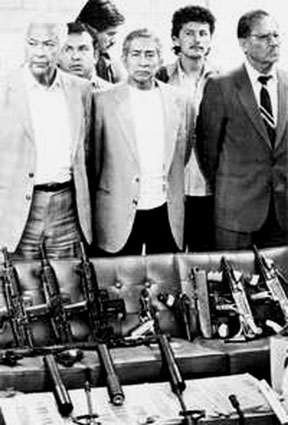 Joaquín
Hernández Galicia (La Quina) when he was arrested in 1989. His
arrest was attack on oil workers and Mexican workers in
general. (Photo: La Jornada)
Joaquín
Hernández Galicia (La Quina) when he was arrested in 1989. His
arrest was attack on oil workers and Mexican workers in
general. (Photo: La Jornada)When La Quina was arrested, it was absolutely necessary to defend him and demand his release, because in going after him, Salinas was targeting a leader who had partially broken from the corporatist system, not-so-secretly supporting Cárdenas in the 1988 presidential elections. Moreover, the PRI president was launching an offensive against Mexican workers in general. After taking his opening shot against a long-time regime loyalist, who was unlikely to resist, Salinas proceeded to go after the CNTE teachers and Section 65 mine workers in Cananea later that year. The bulk of the Mexican petty-bourgeois left, however, lacking a class position, supported or did not protest Salinas’ arrest of La Quina, in the name of “union democracy.”
As we have always insisted, it is not possible to achieve union democracy through the intervention of the capitalist state, the repressive apparatus that enforces the interests of the class enemy, the bourgeoisie. That is why revolutionary Trotskyists refuse, on principle, to sue the unions or otherwise bring the capitalist courts or government into union affairs, and we denounce the pseudo-leftists who do so. If union reformers get into office with the aid of the government they are then beholden to the state and must do its bidding. And they do. This has led to countless betrayals by victorious union “reform” slates in the U.S. Teamsters and elsewhere.
So the basic line of the article, “Mexican Rulers Declare War on Labor” (WV No. 470, 3 February 1989) was correct. The article also correctly notes that “the PRI has maintained itself in power by incorporating the unions and peasant associations into its party-state apparatus.” It quotes an editorial from La Jornada defining corporatism as “the integration of the unions into the state.” All true. But then it equates the oil workers “union” with the Teamsters under Jimmy Hoffa in the U.S. Yet the Teamsters were hardly part of a party-state apparatus, because such a corporatist regime does not exist in the U.S.
While the article on La Quina was correct in its line, but somewhat confused and contradictory in its analysis, there are numerous articles in the Spartacist press, in English and Spanish, which were unambiguous on the class nature of the corporatist “unions.” For example:
- “Mexican Auto Workers Play Hardball,” WV No. 435, 4 September 1987, noted that in contrast to the strike by the independent union at Volkswagen, “the union at Ford belongs to the CTM labor federation which is part of the ruling bourgeois-nationalist ‘Institutional Revolutionary Party’ (PRI) and is keeping the strike under rigid government control.”
- “Mexican Women Workers Arise – Class Struggle in the ‘Global Sweatshop’,” Women and Revolution No. 34, Spring 1988, referred to “‘charros’ – bureaucrats of the government-controlled CTM union federation, who function as labor contractors enforcing sweetheart deals with the owners.” It also referred to the May Day march of “state-controlled unions” and quoted from a Wall Street Journal report on how at a Mexico City dress factory “18 gunmen from the CTM showed up on the day of a union vote, brandished weapons, and terrified the women into voting for a PRI-affiliated union.”
- “Mexico Erupts Over Elections,” WV No. 457, 15 July 1988, refers to “the corporatist, gangster-buttressed CTM union bureaucracy which to this day enforces PRI control of the labor and peasant movements.”
- “Labor Showdown in Mexico,” WV No. 476, 28 April 1989, says: “It will take a class-struggle fight for the independence of labor from the bourgeois state to sweep away the labor cops of the PRI-controlled Mexican Workers Federation (CTM).” Today, Workers Vanguard claims that this didn’t “write off the SNTE as a bosses’ organization.” How do they get that? By quoting the first half of the above sentence but cutting off the reference to the “labor cops” of the CTM. Didn’t they think anyone would track down their quote-chopping, logic-chopping lie?
- “The Only Solution: Build a Revolutionary Workers Party!” Espartaco supplement, August 1994 refers to the “CTM ‘unions’ which have maintained their suffocating hold on millions of Mexican proletarians, chaining the working class to the PRI,” noting how “opposition currents are brutally suppressed by CTM thugs working together with the police.” The article also calls to “elect workers committees independent of state control and all the bourgeois parties (including the PRD), to throw out the charros and lay the bases for real unions as organs of workers struggle.”
- “Maquiladora Workers Strike RCA Thomson,” WV No. 616, 10 February 1995, reported on a walkout against the CTM “union” at the RCA Thomson plant in Ciudad Juárez. The strikers, “mostly young women,” were “demanding that the company labor relations chief be fired and the hated local CTM chief Cruz Mendez ousted. As strikers assembled this morning, some 200 CTM goons, acting in concert with the company, menaced them at the gate.”
- “Mexico Crash Made in U.S.A.,” also in WV No. 616, 10 February 1995, noted that “the CTM is officially incorporated into the PRI as the ‘workers sector’ of the government party.” It continued: “The fight is not just for a few more percentage points in government-controlled wage pacts, but to break the stranglehold of the PRI’s labor police. This has been underlined in the current walkout by maquiladora workers at RCA Thomson in Ciudad Juárez, whose placards declare: ‘Sellout Union Doesn’t Support Us.’ Class-conscious workers must elect workers committees independent of state controls and the capitalist parties (including the PRD) to drive out the bureaucrats and lay the basis for genuine unions as organs of workers’ struggle.” The article also advocated: “Against plant shutdowns and attacks by the bourgeois state and its CTM guard dogs, mass workers mobilizations against repression together with plant occupations backed up by workers defense committees….” [all italics in the original]
- “Mobilize the Working Class Against Repression and the Starvation Assault,” Espartaco supplement, February 1995. Under the subhead “Unchain the Working Class” the article says: “The charro tops, headed by the decrepit ‘Terminator’ Fidel Velázquez, brag once again about supporting the capitalists against the Chiapas Indians and against the workers, naturally including those that he has jailed in the CTM. After signing [PRI president Ernesto] Zedillo’s economic plan, Velázquez promised his bourgeois masters that ‘there will be no disobedience by the workers’,” and called for workers to “donate” a day’s pay to pay off the foreign debt as “a way of showing solidarity with the rich.” It its concluding section, the article says: “Against repression and the starvation assault, it is crucial to now elect workers committees – independent of the bourgeois parties – including the PRD – to break the corporatist shackles of the CTM (which acts as the labor police of the PRI) on the working class).” [italics in original]
- The first installment of a two-part article, “Labor Organizing in the Maquiladoras,” WV No. 620 (7 April 1995), based on a trip to the free-trade zone industrial parks in Tamaulipas and speaking with factory workers there, referred to the “corporatist ‘union’ of the Mexican Labor Federation (CTM),” noting that “the CTM labor federation is a formal part of the Institutional Revolutionary Party (PRI).” It added: “The CTM acts more like a labor contractor than a labor union, as it supplies a ‘disciplined’ workforce to North American investors. Indeed, CTM bosses finger potential militants and run them out of the plants, as well as organizing goon squads to put down any protests. They are literally labor cops for the bosses.”
- Part 2 of “Labor Organizing in the Maquiladoras,” WV No. 621, 21 April 1995, reported on a strike by women workers at a Sony plant in Nuevo Laredo. The CTM leader warned that “we don’t want strikes because they hurt maquiladoras and the investors.” When women struck one plant, the police were sent in. The next day, 200 women were blocking strikebreakers with human chains, the following day there were 300 the article reported, adding: “The CTM unsuccessfully tried to run scabs in with ‘union buses’.” The article summed up: “It will take a class-struggle opposition fighting consciously for the independence of the unions from the bourgeoisie to break the corporatist stranglehold of the PRI-government and the CTM/CT labor cops.” You can’t be any clearer than that.
- “Mexico City: Union-Busting at Gunpoint,” also in WV No. 621, 21 April 1995, reported on the PRI government’s mass firing of 13,000 bus drivers of the independent SUTAUR-100 union. The article noted that “the Mexican bourgeoisie aims to snuff out any idea of organized, independent proletarian struggle,” and that the SUTAUR-100 union had “maintained its separation not only from the PRI-controlled ‘labor’ bodies but also from the various independent unions which in 1988 sided with the former PRI leader Cuauhtémoc Cárdenas, who headed a ‘popular front’ coalition linking various leftists and labor organizations to a wing of the Mexican ruling class.” It underlined “the fundamental fact that the bulk of the Mexican working class is straitjacketed by the PRI’s corporatist ‘union’ federations.”
- “Break the Charro Shackles: For a Class-Struggle Workers Mobilization,” Espartaco No. 7, Winter 1995-96, stated: “The role of the venal charro bureaucracy headed by the CTM, which acts almost as labor contractors and often as hired gunmen for the bosses, has never been so brazenly shown as today…. The workers have sought to heroically resist the capitalist attacks, from 1989 with the military siege of the Cananea mine, the Sicartsa strike and the national strike of the CNTE teachers, as well as the 1990 struggle by the Ford workers and the recent strikes and work stoppages in the maquiladoras…. But in every case, the workers have confronted the brutality and betrayal of the charro bureaucracy, which for decades has been a central pillar of the bourgeois regime.”
- “Release Leaders of Mexico City Bus Drivers Union!” WV No. 642, 29 March 1996, sums up: “For more than six decades, Mexico's bourgeoisie has kept the millions-strong proletariat in thrall by smashing or buying off every attempt to break the stranglehold of ‘unions’ directly controlled by the ruling capitalist PRI (Institutional Revolutionary Party.”
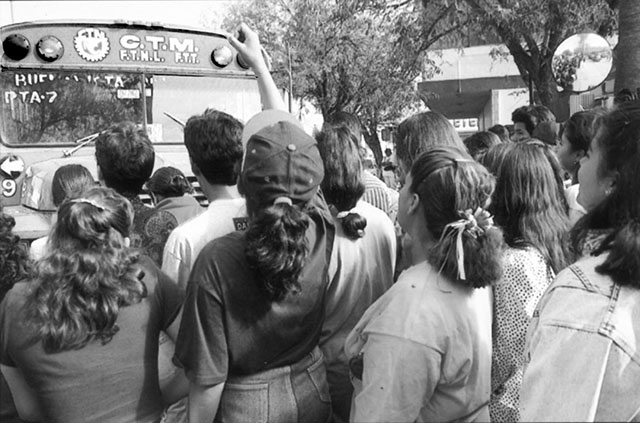
Women workers of the Sony subsidiary Magnéticos de México in Nuevo Laredo repel attempts by “union” bureaucrats of the corporatist CTM to bring in scabs in buses during April 1994 strike.
(photo: Fred Chase/Impact Visuals)
Note also that virtually every one of those articles from 1988 on stresses that it is necessary to win Mexican workers politically away from the popular front around Cárdenas and the PRD.
So here we have more than a dozen articles from past Spartacist publications, all saying, and often spelling out in detail, that the corporatist “unions” such as the CTM and SNTE, are labor cops, strikebreakers, part of the state party, chaining the workers to and controlled by the state apparatus – exactly as the Internationalist Group says today. Who has changed its line is not the IG but the SL and its Mexican offshoot, the GEM. And who is actually supporting and alibiing union-busters is the SL and the GEM.
A word to SLers and GEM supporters who go around with a
photocopy of the one article that had a somewhat confused and
contradictory line on this, pulling it out of their backpacks
with a smug smile thinking they have somehow “got” the IG:
this is not about point-scoring in a game of “gotcha,” it’s
about a deadly (literally) serious question for the class
struggle in Mexico. It matters to us because we are actively
involved in trying to break that corporatist stranglehold, and
the ties that politically subordinate the “independent” unions
to the bourgeois popular front. The SL and GEM don’t give a
damn. And you don’t have to know a lot about Mexico, don’t
take our word for it, all you have to do is go back and look
at the back issues of WV to see that you
have been peddling a lie.
Then start asking questions about the lies you have been told about Brazil.
Trotsky and the Struggle for Revolutionary Leadership in the Unions
Trying to give itself a veneer of orthodoxy, the Workers Vanguard article quotes at length from Trotsky’s unfinished essay, “Trade Unions in the Epoch of Imperialist Decay,” which was still on his desk when he was struck down by a Stalinist assassin in August 1940. Now a good quote from Marx, Engels, Lenin, Trotsky, Luxemburg or other revolutionary figure can be quite useful, particularly when used honestly and relevantly to the issue at hand. We, too, often cite this text. It is a centerpiece of our bulletin Trotskyism and Trade-Union Struggle (December 2005) and guides our work building class-struggle oppositions in the unions on a revolutionary program in the U.S., Brazil and Mexico.
Trotsky pointed to a worldwide trend of unions “drawing closely to and growing together with the state power” and referred to the “semi-state” character of the unions in Mexico. The SL/ICL would have it that we therefore are contradicting Trotsky when we say that the CTM, SNTE, CROC et al are actually state-controlled bodies. They pretend that nothing has changed from 1940, even though at the end of that decade the PRI-government moved decisively to eliminate the last elements of autonomy of those unions, militarily ousting their leaderships and subordinating them from top to bottom to the state party, turning them into strikebreakers and scab-herders who beat up, expel and not infrequently kill their own members.
Then Workers Vanguard quotes Trotsky criticizing those that conclude that “the trade unions cease to be trade unions in the imperialist epoch,” saying that such a position “would be false to the core.” But the League for the Fourth International does not say that unions in general have ceased to be unions, but that the corporatist labor bodies that have been integrated into the capitalist state are not workers unions. The WV article then quotes Trotsky saying that any group “which permits itself an ultimatistic position in relation to the trade unions, i.e., in essence turns its back upon the working class, merely because of displeasure with its organizations, every such organization is destined to perish.” Trotsky is quite correct. But what is he referring to?
Trotsky is talking about the urgency of doing “work within the trade unions” and criticizing those (like the German ultra-lefts in the 1920s that Lenin went after in Left-Wing Communism, an Infantile Disorder) who refuse to work in the unions. Yet the fact is that the sections of the LFI all do work in the unions. We politically support the Comitê de Luta Classista (Brazil), the Comité de Lucha Proletaria (Mexico) and Class Struggle Education Workers (U.S.). And in Mexico we work both in the independent unions and the corporatist labor bodies. The sections of the ICL, however, although they have individual members of unions, don’t do systematic oppositional work in the unions anywhere. So who is ultimatistic here?
Just because some entity calls itself a union, or has “labor” or “workers” in its name doesn’t make it a workers organization. Were the fascist labor fronts in Nazi Germany workers unions? No. Were the unions led by the police agent Zubatov and controlled by the Okhrana (secret police) in tsarist Russia real unions? No. But that didn’t mean that revolutionaries refused to work in them. The ICL when it stood on the program of revolutionary Trotskyism used to understand this, pointing out that the Arab-exclusionist, Zionist Histadrut in Israel was not a bonafide union. But no longer.
In Monterrey, Mexico the sindicatos blancos of the National Federation of Independent Unions (FNSI) are the main labor organizations in town. Are they workers unions? No, they’re company unions. How about when the CTM was awarded the labor contract at the Cananea mine by the government and brought in scabs to break the strike by Section 65 (“The CTM Practiced Scabbing in Cananea, Expert Says,” Dossier Poítico [Hermosillo], 12 June)? That was a scab-herding, strikebreaking outfit that should be driven out by genuine workers unions. But according to the logic of the SL/ICL, that was just a jurisdictional dispute between two unions. Any group that can’t see the class difference between a scab and a worker, between a company union and a workers union, between bosses’ death squads and workers defense guards, is doomed.
Does this all seem very abstract? Let’s make it concrete and contemporary.
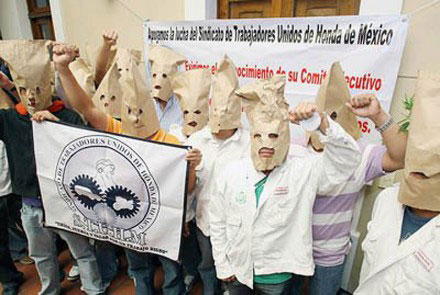 Honda workers members of independent union STUHM
wearing bags over their heads to avoid identification,
December 2010. (Photo: La
Jornada)
Honda workers members of independent union STUHM
wearing bags over their heads to avoid identification,
December 2010. (Photo: La
Jornada) At the Honda auto plant outside of Guadalajara, our comrades
have worked with workers there who are fighting to build an
independent union, the STUHM. When they started out, they
discovered that there supposedly already was a “union” there,
the SETEAMI, an affiliate of the CTM. This outfit had signed a
“protection contract” with management even though none of the
workers had ever heard of it, and never paid dues to it.
Trying to track it down, they discovered that its president
was the company human resources manager! Now another
corporatist outfit, affiliated with the CROC, is claiming to
represent the workers (see “Honda Workers Under Siege: Break
the Corporatist Shackles,” Revolución Permanente
No. 2, May 2013). And the SL/ICL/GEM want you to believe these
are workers unions.
So in summing up, let's return to the key section of Trotsky’s essay:
“It is necessary to adapt ourselves to the concrete conditions existing in the trade unions of every given country in order to mobilize the masses not only against the bourgeoisie but also against the totalitarian regime within the trade unions themselves and against the leaders enforcing this regime. The primary slogan for this struggle is: complete and unconditional independence of the trade unions in relation to the capitalist state. This means a struggle to turn the trade unions into the organs of the broad exploited masses and not the organs of a labor aristocracy.
“The second slogan is: trade union democracy. The second slogan flows directly from the first and presupposes for its realization the complete freedom of the trade unions from the imperialist or colonial state….
“The trade unions of our time can either serve as secondary instruments of imperialist capitalism for the subordination and disciplining of workers and for the obstruction of the revolution, or, on the contrary, the trade unions can become the instruments of the revolutionary movement of the proletariat.”
The latter is what the sections of the League for the Fourth International in Brazil, Mexico and the United States fight for – and the SL/ICL and its moribund Mexican group, the GEM, don’t.
A final note: the Workers Vanguard article concludes by saying that in 1996 the comrades who formed the Internationalist Group in the U.S. and the Grupo Internacionalista in Mexico “departed the Trotskyist ICL.” Actually, no. We were expelled by the ICL, as it began heading down the yellow brick road of centrist opportunism. Who knows where it will end?
The sections of the League for the Fourth International
defend genuine unions against the bourgeois state. We have
always opposed intervention in workers’ affairs by the
capitalist state. Because of our unflinching stand we have
been the subject of state repression, aided and abetted by the
SL and its misnamed International Communist League. It is
tiresome to spend the time to dig up the proof, especially
when our cynical opponents just try to change the subject
whenever they get caught out. But by spinning their web of
lies in the service of capitulation to “their own”
bourgeoisies they will end up trapping themselves. ■
Corporatism in Action in
Chiapas:
SNTE Tops Call in Cops to Shut Down Union
Assembly
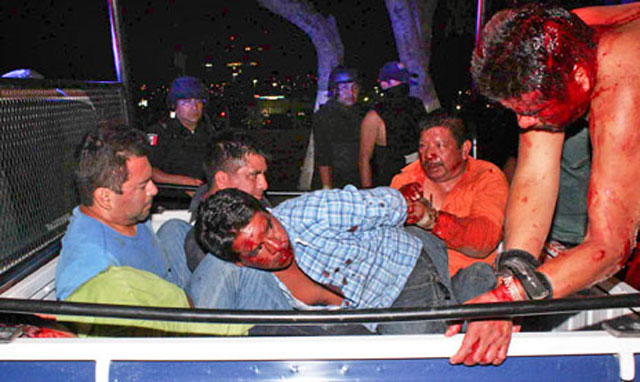
Labor corporatism dead? Tell that to teachers in Chiapas where SNTE tops called in cops to shut down state assembly because CNTE dissidents had majority of the delegates. (Photo: Hugo Sánchez Camacho/La Jornada)
JUNE 30 – Last night around 10 p.m., an elite unit of the state police of Chiapas in southern Mexico assaulted the congress of Section 7 of the SNTE, the corporatist teachers “union,” because the dissidents of the CNTE had a clear majority of delegates. The police used tear gas and then attacked with riot clubs, beating a number of delegates bloody and arresting 29 on charges of “kidnapping.” The dissidents had refused to call off the meeting and stayed in session after the representatives of the SNTE national leadership walked out when earlier on Saturday the roll call of delegates showed that the CNTE had a large majority.
The national SNTE is now headed Juan Díaz de la Torre, formerly secretary general of the organization, after its president-for-life Elba Esther Gordillo was arrested on corruption charges last March. Díaz de la Torre, like Gordillo before him, was installed by the Mexican president as his agent to run the SNTE. (Gordillo was appointed by Salinas de Gortari of the Institutional Revolutionary Party [PRI] in 1989; Díaz was anointed by the Secretary of Government after agreeing to conditions set by current PRI president Enrique Peña Nieto, including supporting the anti-teacher education “reform.”) In return for the SNTE chief’s fealty, the Chiapas state government, headed by a governor of the PRI-allied Green Party (and whose father was a PRI governor of the state), broke up the state teachers congress because the dissidents had control.
While the Spartacist League and its Mexican group, the GEM, claim that the SNTE is a workers union and that it is under attack by the state because of the arrest of used-up state agent Gordillo, the police attack on the Chiapas teachers congress on behalf of the SNTE shows once again, as we have insisted, that this corporatist pseudo-union is an agency of state control of labor. In fact, this charrazo (attempt to impose a state-appointed leadership) was remarkably similar to the original imposition of Jesús de León (“El Charro”) as head of the Railroad Workers Union (STFRM) in 1948 by sending in a contingent of political police (DFS) which closed down a union meeting dominated by leftists and arresting the delegates.
- 1. See “Mexico: Labor Cop Gordillo Busted to Crush Teachers’ Resistance,” The Internationalist No. 34, March-April 2013.
